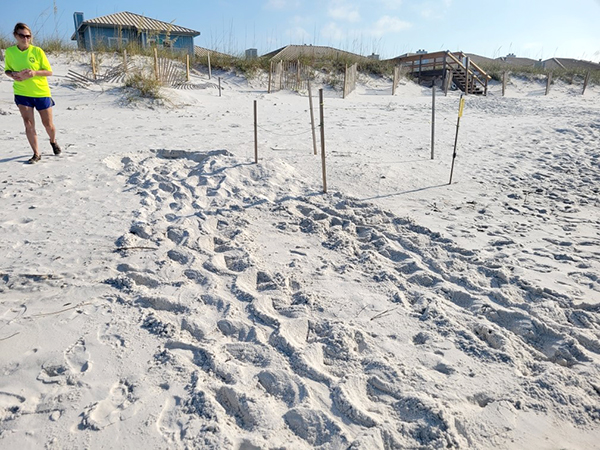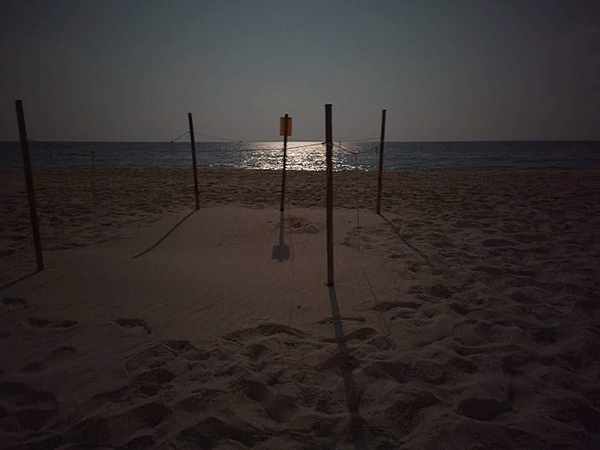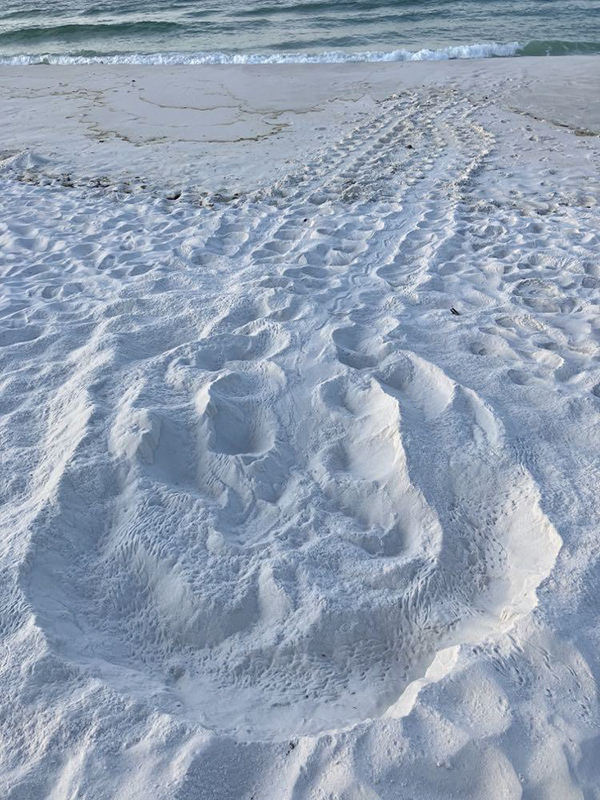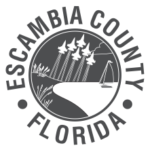
Search by Keyword
Search by Department
All Departments Administration Corrections Development Services Facilities Management Human Resources Information Technology Library Services Management and Budget Services Natural Resources Management Neighborhood and Human Services Parks and Recreation Public Safety Public Works Veterans Services Waste ServicesEscambia County staff and volunteers dedicated thousands of
hours this year to monitoring and protecting sea turtles and their nests on
Pensacola Beach and Perdido Key, along with educating the community about how
they can help protect sea turtles on local beaches.
Volunteers
contributed more than 1,600 hours toward conducting marine turtle nesting
surveys and monitoring activities in Escambia County during the 2023 sea turtle
nesting season, not counting additional hours from county Natural Resources
Management and Marine Resources staff.
County
staff and volunteers begin their daily sea turtle patrol on May 1 each year,
patrolling Pensacola Beach and Perdido Key through the end of August in search
of any sign of sea turtle nests, hatchlings, or turtles in distress.
This year,
Escambia County recorded 13 loggerhead turtle nests and one green turtle nest
on Pensacola Beach, along with two loggerhead turtle nests on Perdido Key.
Although
the nesting numbers were lower than average for both beaches, Escambia County
Marine Environmental Program Manager Mark Nicholas said volunteers and staff
worked tirelessly throughout the season to protect nests and hatchlings from
any negative human impacts.
“We really couldn’t do it without volunteers, so it’s pretty
much a volunteer-driven program,” Nicholas said. “We have people who have been
doing it a long time and some who have only been doing it a couple of years,
but they really like it, and they put in a lot of time and effort into helping spread
the word about turtles.”
When a
sea turtle nest is discovered or reported to the turtle patrol, volunteers will
place stakes around the nest, put up a sign alerting the public to the turtle
eggs, and document the nest’s location using GPS. Volunteers and staff will
then begin checking the nest daily, monitoring for hatchlings and intervening
when necessary to help them reach the Gulf of Mexico successfully.
“About 60% of the time, the hatchlings emerge and they go the wrong way because of light pollution – so they go inland instead of into the Gulf,” Nicholas said. “So we intervene only when needed, and through a couple of different methods, we can try to get the hatchlings into the water. Luckily once they’re floating, they will orient the right way, and they’ll swim offshore where they need to be.”
Sea turtles are protected under the federal Endangered Species
Act and the Florida Marine Turtle Protection Act. When interacting with sea
turtles or their nests, county staff and volunteers work within permit
requirements as authorized through the Florida Fish and Wildlife Conservation
Commission.
Human
impacts can be detrimental to sea turtle nesting, whether it’s using
flashlights on the beach at night, littering, or leaving objects such as
chairs, tents, or umbrellas on the beach, which can disorient hatchlings trying
to make their way to the Gulf of Mexico. Escambia County has special sea turtle
lighting regulations for Pensacola Beach and Perdido Key, and a “Leave
No Trace” ordinance that prohibits leaving items on the
beach after sunset.
Volunteers
work hard to educate beach residents and visitors about how they can do their
part to protect sea turtles, especially when it comes to simple steps like not
using white flashlights on the beach. Volunteers have also distributed hundreds
of red LED flashlights while on patrol, calling it the “Red Light at Night, Sea
Turtle Delight” lighting project. Thousands of red LED flashlights have also
been donated and distributed at the Pensacola Beach Visitor Information Center
to encourage beachgoers to use more turtle-friendly lighting.
“We try
to spread the message to have people turn down their lights, turn them off, or
use red lights instead of white cell phone flashlights,” Nicholas said. “No
light is best, but if we can get them to use red light instead of white light,
then maybe the issue won’t be as bad.”
Stephenie
Allen, who just finished her fourth sea turtle season volunteering with the
turtle patrol, said light is the number one offender when it comes to losing
sea turtle nests. Allen said volunteers have seen increased flashlight activity
on the beach at night, whether it’s people fishing, looking for ghost crabs, or
just taking a walk.
“If
there’s too much white or blue light, then it’s just going to totally turn the
hatchling in the direction of the light,” Allen said. “Same thing with the
nesting turtles – we’ve had them end up in the strangest locations, and it’s
usually due to light pollution.”
In
addition to daily beach patrols, volunteers monitor the Pensacola Beach Gulf
Pier looking for turtles that end up accidentally hooked by fishermen. Through
a partnership with the Gulfarium in Fort Walton Beach, any injured turtles are
transported to the Gulfariam to receive proper care from a veterinarian before
being safely tagged and released when they are ready.
“So we
have volunteers who walk the pier, hoping to be at the right place at the right
time if a fisherman accidentally hooks a turtle,” Nicholas said.
Whether
it’s through turtle rescues, monitoring nests, or educating the public, the
turtle patrol’s main goal is to help ensure that as many sea turtle hatchlings
as possible make it safely into the Gulf of Mexico.
Escambia
County Marine Resources Manager Robert Turpin said the turtle patrol’s mission
not only helps protect endangered and threatened sea turtle species, but it
also bolsters local tourism.
“The fact
that we have turtle nests on our beaches means that our beaches are good for
the turtles and good for us,” Turpin said. “Sea turtles are the icing on the
cake of our wildlife that use our beaches. They are a great indicator that our
beaches and waterways are healthy, and they are a big part of the value that we
derive from healthy beaches and coastal environments – and that benefit
includes hundreds of millions of dollars in tourism. So when we’re protecting
the turtles, we’re protecting our own future as well.”
To learn
more about Escambia County’s “Leave No Trace” ordinance and how you can help
protect sea turtles, visit
the county website.
Sea
turtle nesting season in Florida starts in May and ends Oct. 31. Beachgoers are
reminded to be aware during sea turtle nesting season, and to never disturb
nesting sea turtles or hatchlings.
To report
someone disturbing a sea turtle nest or to report an injured, dead or harassed
sea turtle, call Escambia County
Marine Resources at 850-426-1257, 850-554-5869, or the Florida Fish and Wildlife Conservation
Commission at 1-888-404-3922 (mobile phone: *FWC or #FWC).
To learn more about sea turtles on Escambia County beaches, visit the county’s sea
turtle page.

A female loggerhead turtle on Pensacola Beach.

A turtle patrol volunteer with a sea turtle nest on Pensacola Beach

A sea turtle nest on Perdido Key with hatchlings beginning to emerge.

A loggerhead turtle nest on Pensacola Beach.
Sea turtle-friendly LED flashlights with red lights.

The mission of Escambia County government is to provide efficient, responsive services that enhance our quality of life, meet common needs and promote a safe and healthy community.
Under Florida law, IP addresses and both the content of emails and email addresses are public records. If you do not want your IP address and the content of your email or your email address released in response to a public records request, do not send electronic mail to this entity. Instead, contact this office by phone or in person.

